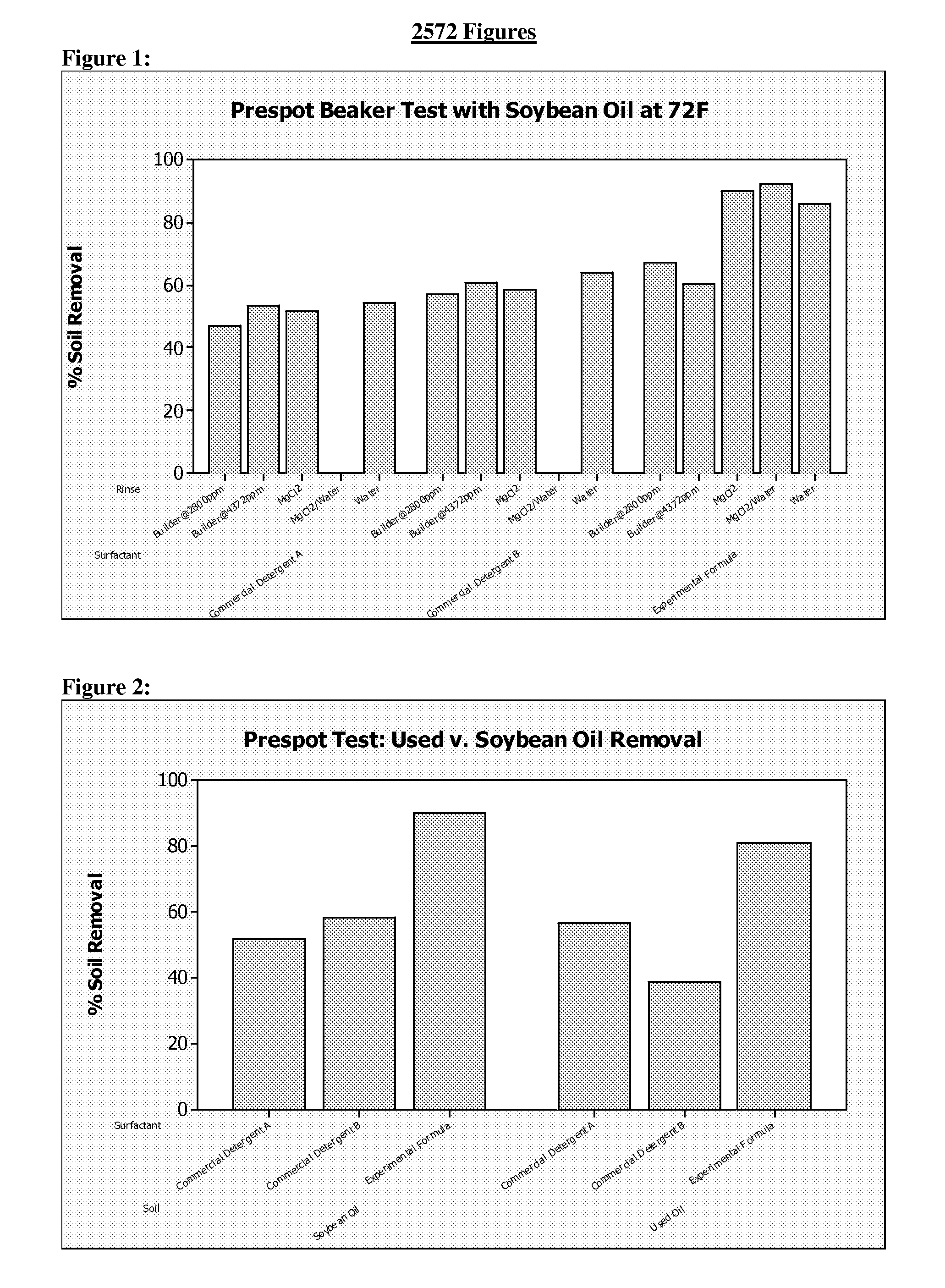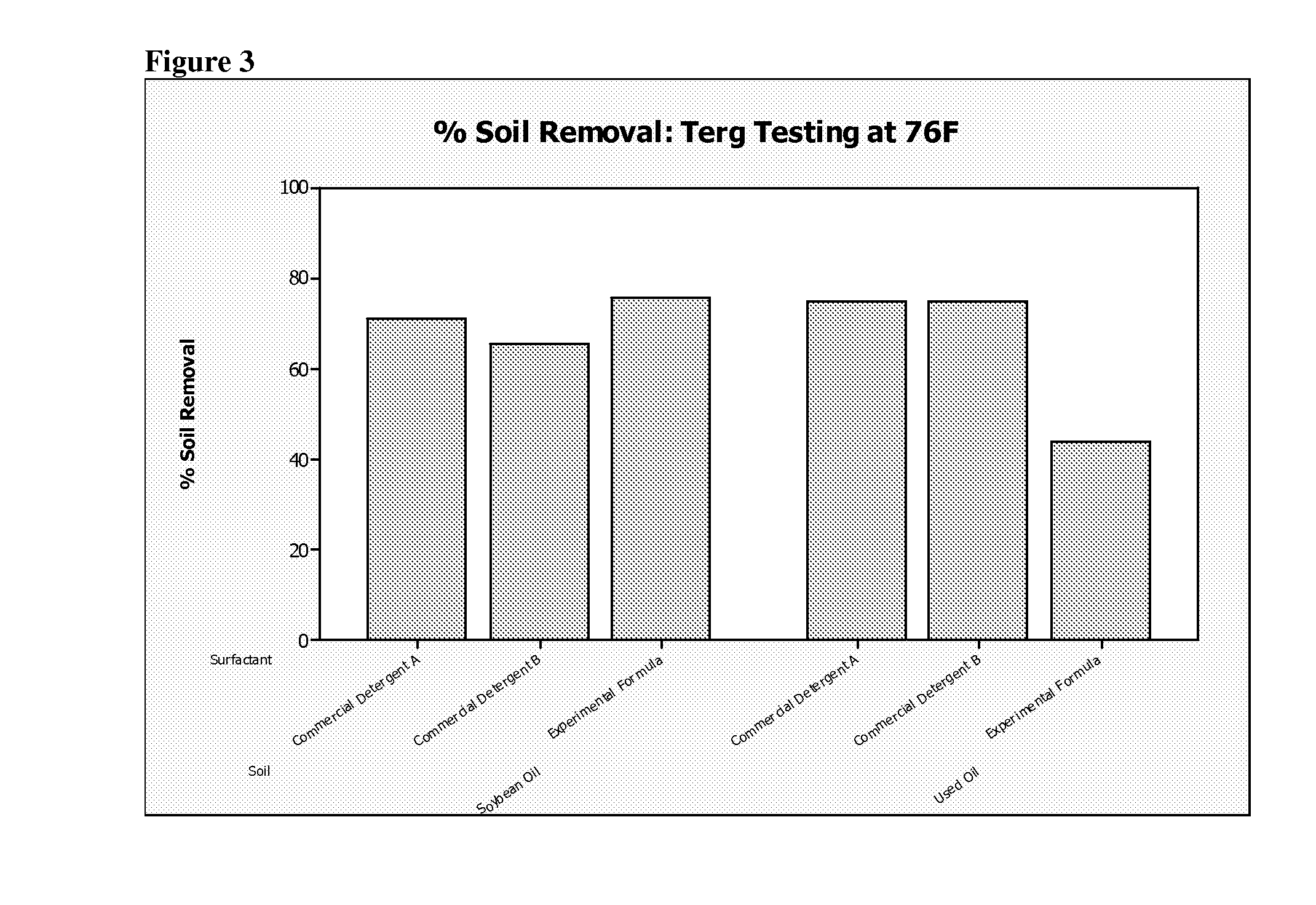Cleaning compositions employing extended chain anionic surfactants
a technology of anionic surfactants and cleaning compositions, applied in the direction of detergent compounding agents, cleaning using liquids, sulfur-based surface active compounds, etc., can solve the problems of difficult removal of non-transfats, and achieve the effect of eliminating non-transfat and fatty acid stains and being highly effectiv
- Summary
- Abstract
- Description
- Claims
- Application Information
AI Technical Summary
Benefits of technology
Problems solved by technology
Method used
Image
Examples
example 1
Synergistic Combinations for Microemulsion Formation.
[0120]Initial work on this invention had shown a synergistic combination of LS (Lauryl Sulfate) (0.0268 Mole %), LES (Lauryl Ether Sulfate) (0.0147 Mole %), LDAO (Lauryl Dimethylamine Oxide) (0.0131 Mole %), Mg2+ (0.0071 Mole %), that lowered the interfacial tension of use solutions vs. corn oil, some to ultra-low range of 10−4 dynes / cm. Data also showed that most of the interfacial tension lowering is due to LES / AO / Mg2+, and that higher levels of Mg2+ (for example, 5 times the level stated above, or even higher) provides even lower interfacial tensions. However, high levels of Mg2+ also increase gelling, making it difficult to manufacture and dispense.
[0121]While not wishing to be bound by any theory, it is surmised that the combination produces surfactant packing that is more planer, and is more prone to form the bi-continuous microemulsions, resulting in ultra-low interfacial tensions at the oil / water interface. The LS and LES ...
example 1a
[0131]The initial formula used in this experiment was: 18.2% Amine Oxide(30% Active), 20.0% Lauryl Ether Sulfate(60% Active), 49.1% Lauryl Sulfate(30% Active), 9.1% propylene glycol and 3.6% water. The propylene glycol was added due to gelling of the surfactant and water mixture.
[0132]50 g of the above solution was used, and soybean oil was added sequentially up to 60.07 g. At this point, the solution was thick, white paste and it appeared that the oil was no longer being emulsified.
[0133]Next, a solution, of 10% Amine Oxide, 11% Lauryl Ether Sulfate, 27% Lauryl Sulfate and 52% water was prepared. This solution did not gel.
[0134]50 g of this surfactant solution was tested and titrated with oil to determine how much the system can hold. Soybean oil was added up to over 50% of the formula (54.96 g), over three times the active surfactant level. The solution got thicker and turned butter yellow.
[0135]Though this formulation can emulsify a significant amount of the difficult non trans f...
example 1b
[0136]A formula containing 1.250% Amine Oxide and 1.375% Lauryl Ether Sulfate, with the same level of soybean oil as active surfactants, the Mg2+ level was varied in order to determine the optimal level. The levels of Mg2+ were: 0 g MgCl2, 0.28 g MgCl2, 1.40 g MgCl2, 2.80 g MgCl2. The balance of each formula is water. Each solution was split into 2 containers, one was held at room temperature and the other was held at 40C. Visual observations of the solutions were made to determine if microemulsion formation occurs.
0 MgCl20.28 MgCl21.4 MgCl22.8 MgCl2AO1.251.251.251.25SLES1.3751.3751.3751.375MgCl2 (30%)0.00.281.42.8DI97.37597.09595.97594.575Soybean Oil1.21.21.21.2
Room Temp1 hour1 day 0 g MgCl2Clear water layer, emulsionClear water layer, emulsionlayer on toplayer on top0.28 g MgCl2Clear water layer, emulsionClear water layer, emulsionlayer on toplayer on top1.40 g MgCl2Cloudy white water layer,Hazy white water layer,emulsion layer on topemulsion layer on top2.80 g MgCl2Cloudy white ...
PUM
 Login to View More
Login to View More Abstract
Description
Claims
Application Information
 Login to View More
Login to View More - R&D
- Intellectual Property
- Life Sciences
- Materials
- Tech Scout
- Unparalleled Data Quality
- Higher Quality Content
- 60% Fewer Hallucinations
Browse by: Latest US Patents, China's latest patents, Technical Efficacy Thesaurus, Application Domain, Technology Topic, Popular Technical Reports.
© 2025 PatSnap. All rights reserved.Legal|Privacy policy|Modern Slavery Act Transparency Statement|Sitemap|About US| Contact US: help@patsnap.com



